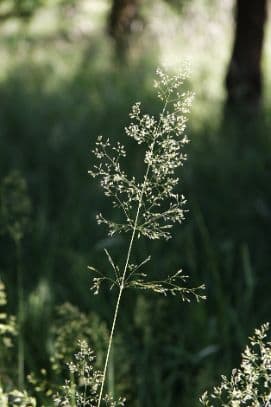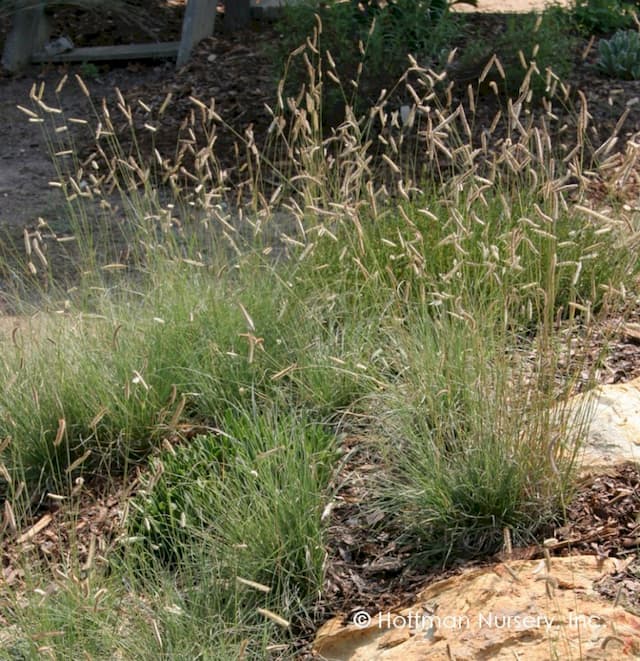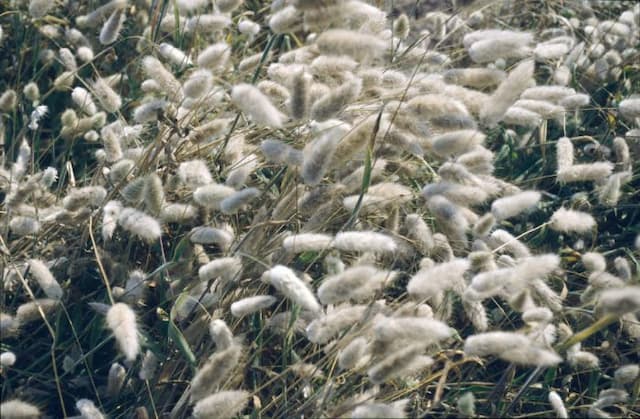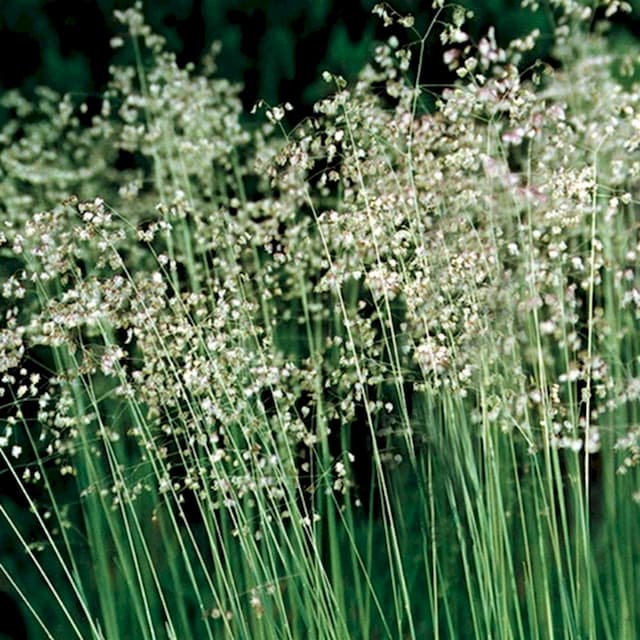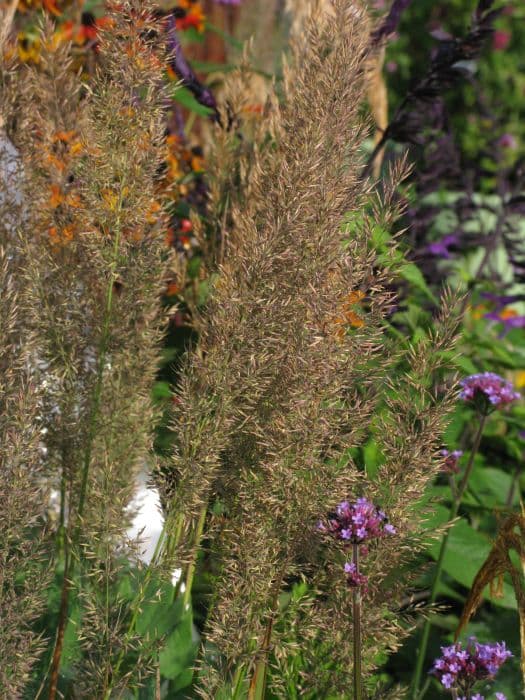Black Fountain Grass Pennisetum alopecuroides f. viridescens











ABOUT
Commonly known as fountain grass, this plant boasts a mounded, graceful growth habit that creates the impression of a soft, green fountain. It features narrow leaves that emerge with a tint of green and can turn golden as the seasons change, creating a visual play of colors in the landscape. The true showstoppers are the bottlebrush-like flower spikes that emerge above the foliage during the warmer months. These flowers start out with a purple to greenish tint and, as they mature, turn into a soft, fawn color, adding an airy texture to the plant's profile. It's often praised for its movement, as the flower spikes and foliage sway elegantly with the wind. Despite its delicate appearance, this ornamental grass has a certain robustness and can adapt to a range of growing conditions, which makes it a favorite among gardeners looking to add a dynamic and flowing element to their landscapes.
About this plant
 Names
NamesFamily
Poaceae
Synonyms
Chinese Fountain Grass, Swamp Foxtail Grass, Green Fountain Grass
Common names
Pennisetum alopecuroides f. viridescens.
 Toxicity
ToxicityTo humans
The plant commonly known as Fountain Grass is not known to be toxic to humans. Therefore, ingesting parts of the plant typically should not cause any symptoms of poisoning or adverse health consequences in humans. However, as with any plant, individuals may have allergic reactions or sensitivities, so it is generally advised to avoid eating ornamental plants.
To pets
Fountain Grass is not known to be toxic to pets. It is not listed among the common poisonous plants for dogs and cats, and there should not be any symptoms of poisoning or severe health consequences for pets that ingest this plant. Nevertheless, ingestion of non-food plants can sometimes cause mild stomach upset in pets, so monitoring for signs of distress is still advisable.
 Characteristics
CharacteristicsLife cycle
Perennials
Foliage type
Deciduous
Color of leaves
Green
Flower color
Varies
Height
2-3 feet (0.6-0.9 meters)
Spread
2-3 feet (0.6-0.9 meters)
Plant type
Grass
Hardiness zones
6
Native area
Asia
Benefits
 General Benefits
General Benefits- Landscape Aesthetics: Fountain grass adds texture and interest to garden design with its graceful, fountain-like foliage and fluffy flower plumes.
- Drought Tolerance: Once established, this ornamental grass is quite drought-tolerant, reducing the need for frequent watering.
- Low Maintenance: It requires minimal care once established, needing only occasional trimming back and is not typically prone to pests or diseases.
- Erosion Control: The root system of fountain grass helps to stabilize soil and prevent erosion, especially on slopes.
- Wildlife Attraction: The seeds of fountain grass provide food for birds, while its dense foliage offers shelter for small wildlife.
- Seasonal Interest: With its late summer to fall blooming, fountain grass looks attractive throughout multiple seasons, changing color in the fall.
- Versatility in Landscaping: It can be used in a variety of garden settings, including borders, rockeries, and as a specimen plant.
 Medical Properties
Medical PropertiesThis plant is not used for medical purposes.
 Air-purifying Qualities
Air-purifying QualitiesThis plant is not specifically known for air purifying qualities.
 Other Uses
Other Uses- Fountain Grass can be used in flower arrangements, both fresh and dried, to add texture and visual interest to bouquets and decorative displays.
- The seeds of Fountain Grass can be utilized as a food source for birds, making it a valuable addition to wildlife gardens or bird-friendly landscapes.
- The foliage of Fountain Grass is sometimes used in the creation of woven crafts, such as baskets, due to its long, flexible blades.
- This grass can be planted as erosion control on slopes or banks, as its root system helps to hold the soil in place and prevent runoff.
- As a natural pest deterrent, Fountain Grass can be utilized in gardens where their movement can help to scare away small rodents and birds from more delicate plantings.
- Fountain Grass can be used in water filtration systems in constructed wetlands, contributing to the removal of contaminants from wastewater.
- The dried inflorescences of Fountain Grass can serve as filling for pillows and mattress toppers, providing a natural and rustic-type cushioning.
- Fountain Grass is often used in landscape photography, where its flowing, fountain-like appearance adds drama and natural beauty to images.
- In educational settings, it can be used to teach students about plant life cycles and ornamental horticulture through hands-on gardening projects.
- As a bioindicator plant, Fountain Grass may be used by ecologists to study changes in ecosystems, particularly how invasive species can alter local biodiversity.
Interesting Facts
 Feng Shui
Feng ShuiThe Black Fountain Grass is not used in Feng Shui practice.
 Zodiac Sign Compitability
Zodiac Sign CompitabilityThe Black Fountain Grass is not used in astrology practice.
 Plant Symbolism
Plant Symbolism- Resilience: Pennisetum alopecuroides f. viridescens, commonly known as Black Flowering Fountain Grass, often grows in tough conditions, symbolizing the ability to thrive despite challenges.
- Elegance: With its slender leaves and arching shape, it is often associated with grace and beauty, making it a symbol of elegance in the garden.
- Growth: As a grass that regenerates and grows quickly, it symbolizes personal growth and the cycle of life.
- Flexibility: The way Fountain Grass moves with the wind represents adaptability and going with the flow of life's circumstances.
 Water
WaterFor the Black Fountain Grass, it is essential to keep the soil consistently moist, especially during its active growing season in spring and summer. The plant should be watered once every week, with about 1 to 1.5 inches of water. During hotter, dryer periods, this frequency may need to be increased to maintain proper moisture levels. Ensure that the soil is well-draining to avoid waterlogging. In the winter months, when the grass is dormant, reduce the watering to every other week or less, depending on the climate.
 Light
LightBlack Fountain Grass thrives in full sun conditions, meaning it requires at least six hours of direct sunlight each day. The plant can also tolerate partial shade, but it performs best and produces the most robust growth when it is situated in a spot that receives full, unfiltered sunlight throughout the day. Avoid placing it in deep shade, as this can impede its growth and flowering capabilities.
 Temperature
TemperatureBlack Fountain Grass is tolerant of a wide range of temperatures, but it flourishes in conditions between 60 and 80 degrees Fahrenheit. It can survive minimum temperatures down to about 20 degrees Fahrenheit, making it hardy up to USDA zone 5. The ideal temperature range promotes healthy growth and flowering, but the grass can withstand occasional dips and spikes beyond these limits.
 Pruning
PruningPruning Black Fountain Grass is important for maintaining its shape and encouraging new growth. The best time to prune is in late winter or early spring, just before new growth begins. Cut back the grass clumps to about 3 to 4 inches above the ground. This pruning frequency is typically annual, to remove old foliage and make room for fresh shoots.
 Cleaning
CleaningAs needed
 Soil
SoilThe best soil mix for Fountain Grass is well-drained, loamy soil with a pH range of 5.5 to 7.0 to ensure optimal growth conditions.
 Repotting
RepottingFountain Grass rarely needs repotting as it is typically grown outdoors; it can be divided every few years to control its spread.
 Humidity & Misting
Humidity & MistingFountain Grass is tolerant of a wide range of humidity levels and does not require specific humidity conditions.
 Suitable locations
Suitable locationsIndoor
Provide bright light, minimal water, and avoid overpotting.
Outdoor
Plant in full sun, well-draining soil, and space 2-3 feet apart.
Hardiness zone
5-9 USDA
 Life cycle
Life cyclePennisetum alopecuroides f. viridescens, commonly known as black-flowering fountain grass, begins its life cycle with seed germination in the spring, as temperatures warm and consistent moisture is available. The seedlings emerge and develop into tufted clumps of arching, green foliage, with growth accelerating into the summer months. During late summer to early fall, the plant produces distinctive black or dark purple flower spikes that rise above the foliage and serve as its reproductive stage, attracting pollinators and dispersing seeds. After flowering, the plant enters a period of senescence in the late fall, where foliage may turn brown and die back with the first frosts. Through the winter, the plant remains dormant, conserving energy in its root system. With the return of spring, the cycle is renewed, with new growth sprouting from the roots to start the process again.
 Propogation
PropogationPropogation time
Spring to Summer
Propogation: The most popular method of propagating Pennisetum alopecuroides f. viridescens, commonly known as black fountain grass, is division. Ideally, this should be done in the spring as the new growth appears. To propagate by division, carefully dig up the clump of the grass and use a sharp spade or knife to split the clump into several pieces. Each piece should have a portion of the root system and several shoots. The divisions can then be immediately replanted into the garden or into pots, ensuring they are placed at the same soil depth they were previously growing. Water the new divisions thoroughly after planting to help establish them. It is important to keep the soil moist until the new plants are well established, which typically takes several weeks.
